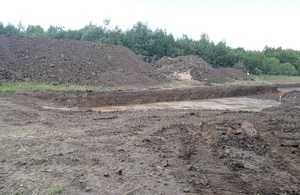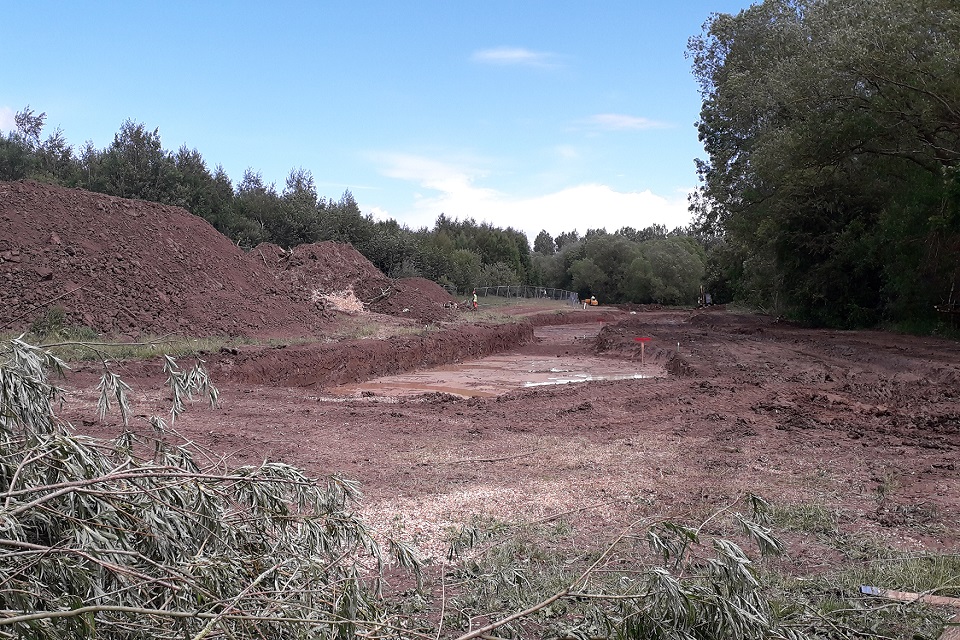Final phase of North East flood scheme starts
Work has started on the final phase of an innovative project to reduce the risk of flooding in a Teesside town.

Work starts at Coatham Wood
Natural flood management features – including three large storage ponds and new water dependent habitats – are being created on land at Coatham Wood upstream of Stockton.
Coatham Wood is next to Coatham Beck, which is a tributary of Lustrum Beck, which flows through Stockton town centre.
The features will store flood water during heavy rain that will then drain slowly back into Coatham Beck. The temporary storage will reduce water levels downstream.
New flood defences
The storage and slower release of water will work hand in hand with £3million in town flood defences which were previously completed in the summer of 2017.
This involved working with Stockton-on-Tees Borough Council to build new flood defences and improve existing ones in the town, and replace Londonderry Bridge.
Also completed as part of the project was a new area of habitat and upstream storage at Sixfields, next to Hartburn Beck, and additional areas of habitat creation at Coatham Wood and Burn Wood. These areas of new habitat have created a haven for wildlife to thrive as well as contributing to the storage of water through ‘slowing the flow’.
Lustrum Beck Flood Alleviation Scheme reduces the risk of flooding to 150 properties in Stockton.

Work starts on storage basins at Coatham Wood
Final phase
For this final phase, the Environment Agency has joined forces with Newcastle University, Arup and Tees Rivers Trust to design the natural flood management features, which are being created on land owned by the Forestry Commission and managed by Forestry England.
It’s expected the work, which his being carried out by contractor Ebsford, will be completed later in the summer. All work is being carried out within current Coronavirus government guidelines.
Dorian Latham, Lustrum Beck Project Manager at the Environment Agency, said:
It’s exciting to be starting on site for the very final phase of the Lustrum Beck project. It’s an innovative approach that provides benefits for flood risk management as well as significant opportunities for wildlife.
We are creating three large flood storage basins that will reconnect historic flood plain and the river at Coatham Beck. They are designed to slow and temporarily store excess water from the beck at times of heavy rain, reducing the volume of water closer to the town.
Lustrum Beck combines engineering solutions in the town centre and natural flood management upstream, which will work together to reduce the risk of flooding to residents, as well as creating vital habitat for wildlife to thrive and the community to enjoy.
Partnership working
The trees planted as part of the natural flood management scheme will be part of a Forestry Commission woodland management plan to make sure it develops to provide a diverse, sustainable habitat.
Alan Eves, Forest Management Director for Yorkshire Forest District, Forestry England, added:
The holding ponds at Coatham Wood complement a range of measures in place across the Forestry England estate.
Working in partnership with others enables us collectively to provide catchment scale flood alleviation that benefits local communities.
Addressing flood risk from the wider river catchment and increasing resilience to flooding through working with multiple agencies and the community has been the focus of a European Union funded project called FRAMES which has run alongside the Stockton scheme. Through this, The Tees Rivers Trust has been working with the Environment Agency and farmers to find opportunities for NFM measures.
It’s important residents understand their flood risk and know what to do during a flood. For more information and to sign up to receive free flood warnings visit the prepare for flooding web pages